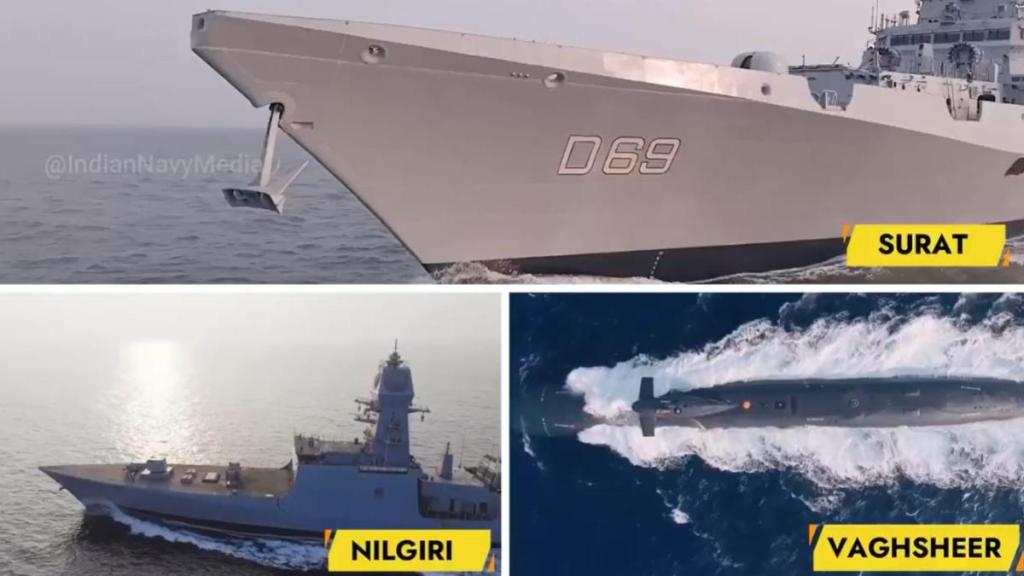At the Naval Dockyard in Mumbai on Wednesday, Prime Minister Narendra Modi commissioned three frontline warships of the Indian Navy — INS Surat, INS Nilgiri and INS Vaghsheer.
Speaking at the ceremony, PM Modi stated that the induction of these advanced naval combatants underscores India’s commitment to becoming a global leader in defence and its strides towards self-reliance. “The commissioning of these warships is a proud moment for the nation, strengthening our maritime capabilities,” the Prime Minister posted on X.
The Indian Navy hailed the occasion as a historic milestone, emphasising the importance of the three state-of-the-art vessels in enhancing India’s maritime strength. INS Surat is a stealth-guided missile destroyer known for its cutting-edge technology and formidable firepower. INS Nilgiri, a frigate, is equipped with advanced sensors and weapon systems designed for multi-role operations. INS Vaghsheer, a Scorpene-class submarine, adds to the Navy’s underwater combat prowess with its stealth and attack capabilities.
15 January 2025
— SpokespersonNavy (@indiannavy) January 14, 2025
A Historic Occasion – Commissioning of Surat, Nilgiri and Vaghsheer.
The landmark ceremony will be Presided over by the Hon'ble Prime Minister @narendramodi@PMOIndia#AatmanirbharBharat#IndianNavy#CombatReady #Credible #Cohesive & #FutureReady Force pic.twitter.com/pkxJGVursz
New Era for the Indian Navy
The commissioning of these three vessels—each representing a significant advancement in India’s naval capabilities—marks a turning point for the Indian Navy. The platforms include Nilgiri, the lead ship of the Project 17A stealth frigates; Surat, the final ship of the Project 15B stealth destroyers; and Vagsheer, the last submarine of the Scorpene-class under Project 75. Together, they demonstrate India’s rapidly growing technological prowess and its ability to design, develop, and build advanced warships and submarines entirely within its borders.
Strengthening Maritime Defence and Self-Reliance
What sets this occasion apart is not only the technological sophistication of these platforms but also the fact that they were built at Mazagon Dock Shipbuilders Limited (MDL) in Mumbai, a symbol of India’s progress in defence self-reliance. These ships and submarines represent more than just advanced engineering—they are a manifestation of India’s commitment to strengthening its indigenous defence production, reducing dependency on foreign suppliers, and advancing its position as a global defence leader.
The commissioning of these assets aligns closely with India’s defence strategy to enhance its operational readiness and technological capabilities, ensuring that the Navy is well-equipped to meet the growing maritime challenges of the Indo-Pacific region.
Nilgiri and Surat: Enhancing Surface Combat Capabilities
The Nilgiri, as the lead ship of the Project 17A class, brings several advancements over its predecessors, particularly in stealth features and radar signature reduction. This frigate is designed with cutting-edge technologies that ensure enhanced survivability, agility, and firepower. With advanced sensors and the capability to operate a variety of helicopters—including the MH-60R, recently inducted into the Navy’s fleet—Nilgiri is a multi-role asset prepared to counter any surface, sub-surface, or air threat.
Similarly, Surat, the final ship of Project 15B, brings an upgraded and more capable design compared to earlier Project 15A destroyers. Featuring enhanced weapon systems, improved air defence capabilities, and better survivability features, Surat is poised to be a cornerstone in India’s surface combat fleet. The destroyer’s advanced communication systems and integrated platforms also ensure it is ready for high-end combat operations across the vast Indo-Pacific region.
Together, Nilgiri and Surat provide the Indian Navy with the ability to maintain naval superiority, protect critical sea lanes, and project power across the Indian Ocean and beyond.
Vagsheer: Boosting Submarine Warfare Capabilities
The induction of Vagsheer, the sixth submarine in the Kalvari-class Project 75, bolsters India’s underwater warfare capabilities. This Scorpene-class submarine is equipped with modern torpedoes, anti-ship missiles, and advanced sonar systems, making it one of the most silent and effective diesel-electric submarines in the world.
Vagsheer is not just a formidable weapon for anti-surface and anti-submarine warfare; its modular construction allows for future upgrades, including the potential addition of Air Independent Propulsion (AIP) technology. This would further extend the submarine’s operational range and endurance, providing India with a strategic advantage in the region’s complex underwater domain. With the growing naval power of China in the Indo-Pacific, having a capable, stealthy, and versatile submarine fleet is critical to maintaining a balance of power.
Bigger Picture: Maritime Security and Strategic Autonomy
The simultaneous commissioning of Nilgiri, Surat, and Vagsheer is a statement on multiple fronts. It underscores India’s growing maritime influence and its commitment to securing not only its own waters but also ensuring stability across the Indian Ocean and the broader Indo-Pacific region. In the face of rising tensions and increased naval activity in these waters—particularly from China—India’s enhanced naval capabilities will play a crucial role in ensuring the freedom of navigation and countering potential maritime threats.
More than just a boost to India’s military might, these ships and submarines reflect the Navy’s broader strategy of self-sufficiency. As the country increasingly turns to indigenous solutions, it is making significant strides in its defence ecosystem. The successful construction of these platforms, built primarily with Indian technology, helps foster greater defence innovation and industrial growth while contributing to India’s “Make in India” initiative.
A Game-Changer for India’s Maritime Future
The commissioning of Nilgiri, Surat, and Vagsheer is a transformative moment for the Indian Navy, one that will resonate far beyond the dockyards of Mumbai. These platforms enhance India’s ability to project power, defend its maritime borders, and protect its growing economic interests. They also serve as a symbol of India’s self-reliance in defence manufacturing, reinforcing the nation’s emerging role as a major naval power.
As the world watches India bolster its maritime capabilities, the commissioning of these ships and submarines is a clear signal of the Navy’s readiness to defend the country’s strategic interests while ensuring peace and stability in the Indian Ocean region. India’s naval future has never looked stronger, and the impact of this historic event will reverberate for years to come.

